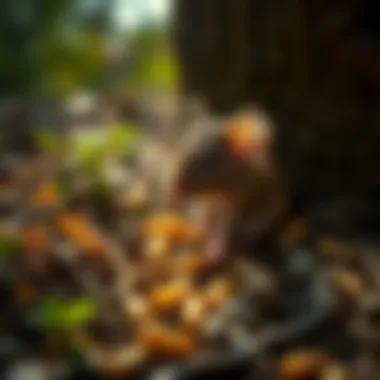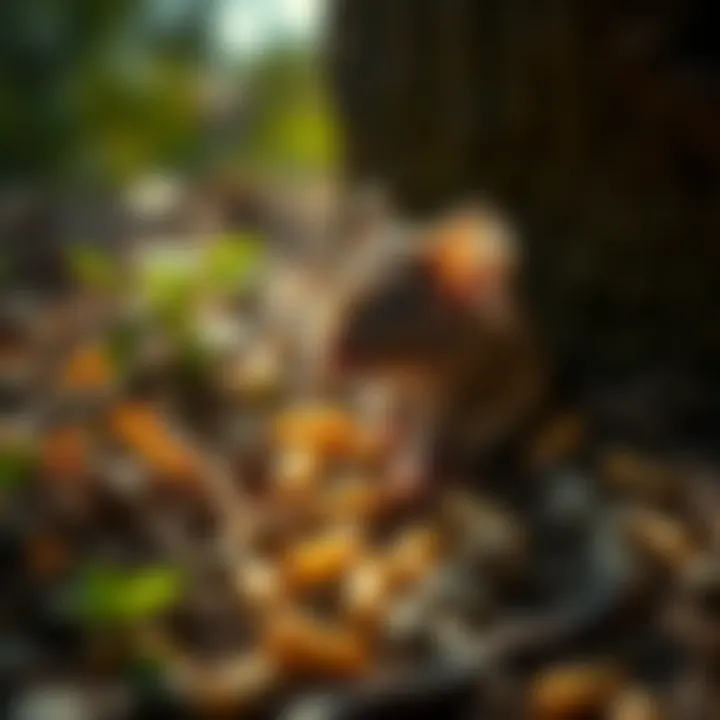Understanding Professional Strength Mouse Poison


Intro
Dealing with any rodent problem can feel like trying to catch smoke with your bare hands. Mouse infestations, while often deemed a nuisance, can escalate into serious health risks and property issues. Understanding professional strength mouse poisons is crucial for homeowners and pest control professionals alike. These substances are not just your average traps or baits; they are powerful formulations designed to deal with infestations effectively. This guide leads you through the nitty-gritty of these products—from their makeup and how they work to safety guidelines and regulatory concerns.
It's no picnic to face rodents, and when the stakes are high, being armed with the right knowledge is half the battle. With effective pest management strategies, understanding how to use these poisons safely becomes paramount, allowing for informed decisions that are both effective and environmentally conscious.
Understanding the Pest
Exploring the behavior and characteristics of mice illuminates why professional strength poisons are sometimes necessary.
Identification
Mice, specifically the house mouse (Mus musculus), are small, agile rodents that often set up shop in homes. They boast a flexible body that allows them to slip through small cracks and crevices. Identifying them accurately is the first step in managing an infestation. Identifiable traits include:
- Color: Usually brown or grey
- Size: Adult mice typically weigh between 1-2.5 ounces
- Nose: Pointed snouts
Observing droppings or gnawed materials can also signal a mouse presence, as they tend to leave telling signs behind.
Life Cycle
Understanding their life cycle is equally crucial. Mice reproduce quickly; a single female can mate with several males and produce a litter of 5-10 babies, and can do so as often as every three weeks. This rapid reproduction rate forms the backbone of their problems in domestic spaces. Knowing the life cycle of mice helps in determining the best time to implement control measures:
- Gestation: Approximately 19-21 days
- Maturity: Young mice mature within about 6 weeks
- Lifespan: Typically, mice live for 1-2 years in the wild, but the indoor environment can provide them a longer lifespan due to lack of predators.
Understanding these factors gives insight into the urgency of applying stronger control measures when infestations are identified.
Pest Prevention Strategies
Before resorting to the heavier artillery of professional poisons, homeowners should consider fundamental prevention strategies.
Environment Modification
Let’s start with the basics. Making your environment less inviting for mice can be incredibly effective. Here are a few tips:
- Seal Cracks and Holes: Mice can squeeze through openings larger than a dime. Use caulk or steel wool to seal gaps.
- Declutter: Keep attics, basements, and garages organized and free from debris. Mice thrive in clutter.
- Food Storage: Store food in airtight containers and clean up crumbs quickly to avoid attracting these unwelcome guests.
Physical Barriers
In addition to environmental modifications, employing physical barriers is key. Think of these as the first line of defense. Use:
- Metal mesh to block potential entry points.
- Heavy-duty traps for immediate deterrence.
- Rodent-proof bins to keep food items secure from munching.
These strategies create a robust environment that is far less appealing to mice and can significantly reduce the probability of infestation.
Control Methods
Sometimes, despite your best efforts, the presence of mice becomes unavoidable. In such cases, understanding the control methods available is essential.
Chemical Control
Professional strength mouse poisons fall into this category. They work effectively by either anticoagulating the blood or interfering with the mouse’s nervous system. These poisons are sophisticated formulations designed for quick action, often requiring only a single feeding to yield results. However, these substances must be used very carefully to prevent unintended harm to pets, wildlife, or children.
Biological Control
Exploration into biological control methods is an emerging field, focusing on natural predators of mice or the use of specific parasites. While not as popular or as immediate as chemical methods, fostering natural predators in the ecosystem provides a long-term strategy worth considering. These methods underscore the importance of an integrated pest management approach, balancing between chemical and natural interventions.
Effective pest management is like a tightrope walk. One wrong step can tip the balance, leading to greater havoc.
Staying informed about the types of rodenticides, alongside employing practical prevention strategies, provides homeowners and pest control professionals with the tools needed for effective rodent management. Understanding these elements ensures not only effective control but also alignment with safety and environmental standards.
Foreword to Professional Strength Mouse Poison
Understanding mouse poisons is vital for anyone dealing with rodent problems. After all, these pests can wreak havoc in homes, affecting not just the structure but also the health of those living inside. People often underestimate the significance of using professional strength mouse poison, thinking that supermarket products will suffice. But let’s be real, mouse infestations are no small matter. When facing a larger issue, it’s not just about killing rodents; it’s about ensuring that the methods employed are effective, safe, and comply with regulations.
Overview of Rodent Control
Rodent control is a crucial aspect of maintaining a healthy living environment. Typically characterized by the presence of mice, rats, and sometimes squirrels, these critters can carry diseases and damage property. Severe infestations can lead to unsanitary conditions that pose direct risks to family members. It’s not just about eliminating what you see; proactive control measures can prevent future infestations.
When embarking on rodent control, one must consider the life cycle of these animals. Mice reproduce quickly, making swift action necessary. By using professional-grade mouse poisons, homeowners and specialists get access to potent formulations that can tackle larger infestations effectively. In addition, a variety of application methods, such as bait stations and direct treatments, ensure that these poisons can be applied strategically, leaving no stone unturned.
Importance of Professional Strength Products


Turning to professional strength products is a game changer in rodent control. While many might reach for the generic mouse traps or small-scale poisons, such choices often lack the necessary strength to handle significant infestations. It’s the difference between putting a Band-Aid on a broken leg versus getting proper medical treatment.
Professional strength mouse poisons contain a higher concentration of active ingredients that target rodent physiology. This means they work faster and more effectively than their retail counterparts.
Here are a few notable benefits of opting for these products:
- Efficacy: They deliver superior results by inducing lethal effects swiftly, reducing the chance of continued damage or health risks.
- Targeted Approach: Many formulations are designed to minimize non-target species’ exposure, helping to protect pets and other wildlife.
- Expert Guidance: When using professional strength products, it is often beneficial to consult pest control professionals who understand the nuances of application and local regulations.
"Choosing the right poison is not simply about efficacy; it’s also about safety and environmental impact."
In sum, the importance of professional strength mouse poison can't be overstated. For housewives and homeowners alike dealing with this pesky issue, understanding these crucial aspects can pave the path to effective and responsible rodent management.
Chemical Composition of Mouse Poisons
Understanding the chemical composition of mouse poisons is fundamental for both safety and efficacy in rodent management. The correct formulation of these substances directly impacts their effectiveness against mouse populations in various environments. Knowledge of the specific ingredients not only guides pest control professionals but also empowers homeowners to make well-informed decisions when choosing rodenticides. Familiarity with these components can help mitigate risks and promote environmental safety, leading to more sustainable pest management practices.
Active Ingredients Explained
Mouse poisons typically contain a variety of active ingredients tailored to target rodents effectively. Common types include anticoagulants, such as bromadiolone and brodifacoum, which disrupt the blood clotting process in rodents. These substances are often chosen for their delayed action; mice may not realize they've ingested poison until it’s too late, leading to better control.
Other active ingredients include zinc phosphide, which releases phosphine gas when it comes into contact with moisture. This method results in more rapid intervention but requires careful handling because of potential risks to non-target species. Moreover, some formulations incorporate naturally derived compounds from plants like strychnine and warfarin, popular in certain formulations for their potency.
It's crucial to recognize that different manufacturers may employ distinct combinations of these ingredients, which can significantly vary in terms of effectiveness and safety. Homeowners should always consult the product label for details on specific active ingredients and their respective concentrations.
Understanding the Toxicity Levels
The toxicity levels of the chemicals in mouse poisons are a critical factor when assessing the appropriateness of a product for residential use. Toxicity is typically measured using the LD50 (lethal dose for 50% of the population) metric, which indicates how much of a substance is needed to cause death in half of a test population. In rodenticides, lower LD50 values signify higher toxicity, and consequently, greater risks to non-target animals and humans alike.
- High Toxicity: Products containing brodifacoum often have a low LD50 and should be used with utmost caution. While effective in larger infestations, their use in residential settings necessitates rigorous adherence to safety guidelines.
- Moderate Toxicity: Alternatives like bromethalin possess moderate toxicity but may not be as widely recognized or understood. They act quickly, thus requiring quick decision-making on the homeowner's part.
- Low Toxicity: Less toxic options, such as warfarin, may require multiple feedings to achieve lethal effects, which can sometimes provide opportunities for non-target species to be influenced by bait, thus posing environmental risks.
It's essential to carefully read product labels not only for active ingredients but also for hazard warnings regarding toxic effects on humans and pets.
In summary, selecting the right rodenticide hinges not just on the efficacy of its active components but also on their toxicity levels. Responsible use will help reduce the potential hazards associated with pest control while promoting effective management of rodent issues.
Types of Professional Strength Mouse Poisons
When facing an infestation, understanding the various types of professional strength mouse poisons is crucial. Different formulations serve diverse purposes and cater to various situations. Knowing what's out there can make a significant difference in effective rodent control and can even help to mitigate potential risks to non-target species.
Anticoagulants
Anticoagulant rodenticides are perhaps the most commonly utilized category of mouse poisons. They work by preventing the blood from clotting, ultimately leading to the rodent’s demise. The effects don’t show immediately; instead, there’s a delay, which can range from days to even a week. This delay is both an advantage and a drawback. On one hand, it allows multiple rodents to consume the bait before anyone notices anything amiss. On the other hand, this protracted process can sometimes lead to concerns regarding the safety of pets or wildlife who might inadvertently consume the poisoned rodents.
Key Characteristics of Anticoagulants:
- Second-Generation Anticoagulants: These are particularly potent and require a smaller dose to be effective. Examples include Bromadiolone and Brodifacoum.
- First-Generation Anticoagulants: These include compounds like Warfarin and Chlorophacinone, which might take a longer time and more bait to be effective.
- Safety Concerns: While they are effective, their use must be monitored carefully. Ingestion by pets or wildlife can lead to unintended consequences.
The process of using anticoagulants involves setting bait stations in strategic locations where rodent activity has been observed. Understanding the behavioral patterns of the rodents can also maximize the effectiveness of these poisons.
Non-Anticoagulants
Non-anticoagulant poisons operate on different mechanisms and include a variety of active ingredients that act more quickly than anticoagulants. They can effectively reduce rodent populations with fewer bait interactions as they often lead to quicker outcomes. However, the need for precision in application is paramount, as they can be riskier for both target and non-target species.
Common Types and Their Mechanism:
- Bromethalin: This neurotoxin causes paralysis in rodents and has a faster action, often within 24 hours.
- Cholecalciferol: A vitamin D3 analogue, this compound leads to hypercalcemia, causing kidney failure in rodents.
- Strychnine: Although less common today due to its danger, strychnine induces convulsions and a swift death.
Given the speed and potency of non-anticoagulants, they can be beneficial in situations where a rapid decline in population is needed. However, caution is advised to ensure they are not accessible to pets or children. The timing and placement of these baits become critical for successful application.
Multi-Feed vs. Single-Feed Formulations
When choosing between multi-feed and single-feed formulations, the choice can profoundly affect the outcome of your pest management efforts.
Multi-Feed Formulations
These rodenticides require multiple feedings to achieve lethality. Given their lower toxicity level, they are often favored in settings where other wildlife might be present, reducing the risk of unintended harm.
- Pros: Safety for non-target wildlife; often encouraged for household use.
- Cons: Longer timeframe for effectiveness can delay outcomes, depending on the cached bait.
Single-Feed Formulations
As the name suggests, these formulations require only a single feeding to be lethal. With potent active ingredients, they often appeal to pest control professionals needing immediate results.


- Pros: Rapid action to reduce severe infestations; ideal for immediate rodent threats.
- Cons: Higher risk for non-target species, especially pets, as they might consume the poisoned rodents or bait directly.
Ultimately, the choice between these formulations often hinges on the specific use case and the awareness of potential risks. Both options serve their purpose in a comprehensive pest management strategy. Understanding these distinctions prepares homeowners and pest control professionals alike to make informed decisions when deploying professional strength mouse poisons.
Application Methods for Mouse Poison
Understanding the application methods for mouse poisons is critical for ensuring effectiveness while maintaining safety. Rather than relying solely on traditional methods, savvy pest control professionals and homeowners should be aware of various methods that successfully align with their environment and specific rodent challenges. Good application techniques can maximize the impact while reducing risks to non-target species and minimizing environmental contamination.
Bait Stations
Bait stations are a highly favored method in the application of mouse poisons. These are specially designed containers that hold poisoned bait securely, allowing rodent access without exposing other animals or children to the toxic substances. An attractive feature of bait stations is their ability to keep the bait fresh and uncontaminated, even in outdoor settings.
The benefits of using bait stations are numerous:
- Controlled Access: They restrict entry to only rodents, hence decreasing the risk of poison exposure to pets and wildlife.
- Protection from Weather: Being covered, bait stations protect the bait from rain and moisture, ensuring its effectiveness longer.
- Monitoring Capability: Many bait stations come with clear windows, allowing for easy observation of bait consumption without disturbing the station itself.
Place bait stations along known rodent pathways, such as walls or corners, where the little critters tend to scurry. Think about using multi-feed formulations in bait stations, as these encourage repeat visits and enhance the likelihood of successful pest elimination.
Track Stations
Track stations serve a somewhat different yet complementary purpose to bait stations. These are used primarily for monitoring rodent activity rather than delivering poison. A track station typically contains a non-toxic bait or a surface that captures rodent footprints, allowing pest control specialists to determine the level of infestation in a given area.
Utilizing track stations can assist in:
- Assessing Population Levels: By tracking rodent activity, one can judge the size of the problem and decide on the necessary measures needed.
- Identifying Species: Different species may require different approaches. Knowledge in identifying footprints helps in choosing the right strategy.
- Strategic Planning: Information gathered from track stations guides the placement of bait stations or traps, enabling a targeted and efficient response.
Tip: Ensure that the track stations are placed along easy access points, generally where droppings or signs of gnawing can be noticed. This data-driven method allows for a more tailored pest control approach.
Direct Application Techniques
Direct application is another method where mouse poison is applied without the aid of bait or track stations. This can involve placing the bait directly in rodent nests or burrows. While this approach can prove effective for localized infestations, it demands careful consideration to avoid unintended exposure to other animals or humans.
Some important factors to consider when using direct application techniques include:
- Targeted Placement: Specific application in known nesting areas or burrows minimizes the risk of the poison affecting non-target species.
- Controlled Dosage: Ensuring the right amount is vital; too little may not achieve the desired effect, while too much could pose a risk to unintended victims.
- Post-application Monitoring: Like bait stations and track stations, monitoring after application is critical to ensure that the desired outcome is being met.
Safety Considerations When Using Mouse Poison
Using professional strength mouse poisons is a significant step in rodent control, yet it must be approached with caution. The importance of safety considerations can't be understated. These poisons are potent, formulated to eliminate pests effectively; however, if mishandled or improperly stored, they can pose serious risks to humans, pets, and the environment. Adhering to safety practices not only ensures efficacy but also safeguards your household and surrounding ecosystem.
Handling and Storage Guidelines
When dealing with mouse poisons, proper handling and storage procedures are paramount. It is essential to keep these substances in their original containers, clearly labeled, and securely closed. This helps keep them out of reach of children and pets. Always wear gloves when handling mouse poison to avoid direct contact with the skin.
Here are some practical guidelines for handling and storage:
- Use protective gear: Gloves and masks can be your best friends when dealing with toxic substances.
- Follow manufacturer’s instructions: Each product comes with specific directions—stick to them like glue.
- Store in a cool, dry place: High temperatures and humidity can degrade the chemical composition, making them less effective.
- Seal tightly: Ensure that lids are tightly closed to prevent spills or accidental exposure.
It's wise to periodically check your storage area for leaks or broken seals. If any product is damaged, it should be disposed of according to local regulations, often involving hazardous material disposal services.
Environmental Safety Practices
Ensuring the safety of the environment when using mouse poisons is an essential aspect that is often overlooked. The chemicals within these rodenticides can seep into waterways and affect non-target species, raising the stakes considerably. Proper practices can mitigate those risks significantly.
Here are some recommended environmental safety practices:
- Avoid using near bodies of water: Rodenticides should be placed away from lakes, rivers, or streams to prevent contamination.
- Implement bait stations: This method not only engages the intended targets but also minimizes exposure to other wildlife.
- Monitor for secondary poisoning: Keep an eye on any animals that might be affected indirectly through consuming poisoned rodents. Regularly check for signs of animal distress or death in the vicinity.
- Educate your community: Spread the word about safe practices when using rodenticides. Knowledge is a powerful tool that can protect both humans and animals alike.
"Safety is not just a priority; it's a way of life when handling rodenticides. Ensuring your practices are sound keeps everyone, including our environment, safe."
These considerations reflect a responsible attitude towards pest control, underlining the unity of efficiency and responsibility in eradicating rodent problems. By integrating these safety measures, you not only make your home a safer place but help protect the environment, creating a balanced approach to managing pest issues.
Regulatory and Legal Aspects
The control of rodent populations using poisons is a deeply regulated area, important for ensuring both public safety and environmental protection. These regulations help in establishing standards for effectiveness, safety, and environmental impact of the substances employed in pest management. Understanding the regulatory and legal aspects surrounding these chemicals is crucial for pest control professionals and homeowners alike. It provides a framework that aids in responsible usage and compliance while also ensuring the effectiveness of methods used against rodent infestations. Moreover, being aware of regulations can mitigate legal risks associated with improper handling or application of rodenticides.
Federal Regulations on Rodenticides
At the federal level in the United States, the Environmental Protection Agency (EPA) plays a pivotal role in overseeing the registration and use of rodenticides. The Federal Insecticide, Fungicide, and Rodenticide Act (FIFRA) regulates the sale, distribution, and use of pesticides, including mouse poisons. Under this law, any substance intended for pesticide purposes must be registered with the EPA before it can be marketed. This registration process ensures that products meet safety standards for humans, non-target animals, and the environment.
- Safety and Efficacy Requirements: The EPA requires manufacturers to submit extensive data on the safety and efficacy of their products. This data must include information about how the rodenticide affects target rodents as well as non-target species, which assists in assessing potential ecological impacts.
- Labeling and Usage Restrictions: Approved products must have specific labeling to inform users about possible hazards, proper handling procedures, application methods, and first-aid measures. This labeling is crucial for ensuring safe application.
- Periodic Review: The EPA conducts periodic reviews of registered rodenticides to ensure they continue to meet safety standards and do not compromise public health or environmental safety over time.


State-Specific Guidelines
In addition to federal regulations, each state has its own set of rules that govern the use of rodenticides. These guidelines may vary significantly, reflecting differing local environments, wildlife considerations, and pest populations.
- State Registration: Certain states may mandate additional registration for rodenticides before they can be sold or used, beyond federal requirements. This means that pest control operators need to be well-versed in state regulations, which may require tailored licenses or certifications.
- Local Restrictions: Some states implement restrictions based on specific local conditions, such as proximity to bodies of water or the presence of endangered species. Homeowners and professionals must be acutely aware of these regulations to avoid penalties or environmental harm.
- Use of Non-target Species Considerations: Certain states have strict laws regarding the usage of rodenticides in areas where non-target species, like pets or wildlife, might be affected. This could lead to significant limitations on the locations and methods used for rodent control practices.
"Understanding local regulations is key for both effective pest management and compliance with the law. Ignorance is no defense!"
By adhering to both federal and state-specific regulations, homeowners and professionals can ensure that they are using rodenticides responsibly, effectively, and legally. This knowledge protects not only individuals but also the broader ecosystem from potential harm.
Integrated Pest Management Strategies
When it comes to managing rodent infestations, a one-size-fits-all approach doesn’t cut it. Integrated Pest Management (IPM) strategies represent a thoughtful, holistic method of pest control that combines various techniques to effectively tackle the problem. In the context of professional strength mouse poisons, IPM is essential for maximizing benefits while mitigating potential negative impacts on the environment and non-target species.
Complementing Poisons with Traps
The dual approach of using poisons in conjunction with traps can be highly beneficial. While poisons aim to eliminate rodents through their ingestion, traps can quickly capture and remove them from your immediate environment. This method reduces the time rodents spend in your space, thereby decreasing the likelihood of damage or disease transmission.
- Types of Traps: There are several types of traps available, including snap traps, glue boards, and electronic traps. Each has its pros and cons, so the choice should be based on the specific situation in your home. For instance, the catch-and-release options may appeal to those who wish to avoid killing the rodents.
- Placing Traps Effectively: Traps should be set in areas where rodent activity is observed. Along walls, behind appliances, or in corners where droppings are found can be prime spots. This not only increases the chances of catching them but also serves as an immediate line of defense while the poisonous bait works its magic.
- Monitoring and Maintenance: Regular monitoring of traps is crucial; they need to be checked frequently to ensure efficacy and to remove any captured rodents promptly. This act of diligence not only maximizes effectiveness but also maintains hygiene in your living space.
Environmental Modifications
An often overlooked aspect in the realm of pest management is the modification of the environment to make it less inviting for rodents. Proactive changes can prevent infestations before they begin, complementing the use of professional strength poisons. Here’s what you might consider:
- Sealing Entry Points: Rodents are notorious for squeezing through holes and cracks that seem almost impossible. Conduct a thorough inspection and seal off any openings with durable materials. Using materials like steel wool or silicone caulk can deter tiny intruders.
- Proper Food Storage: Keeping food in airtight containers and ensuring leftovers are properly sealed will limit available food sources for rodents. Keep your kitchen tidy and free from crumbs on the counters or floors; vigilance here goes a long way.
- Decluttering: A cluttered space invites pests. Regularly declutter your home, particularly in areas like basements and attics. This not only reduces surfaces for rodents to hide but also makes monitoring for signs of infestations much simpler.
- Landscaping Considerations: Trim back trees, shrubs, and plants from the exterior of your home. Rodents can use these as pathways into your home. Keeping your yard tidy and reducing places for them to hide is a fundamental step.
"An ounce of prevention is worth a pound of cure.” This adage rings particularly true in pest control.
By implementing these integrated pest management strategies, not only do you enhance the efficacy of professional strength mouse poisons, but you also adopt a sustainable approach that prioritizes health and safety in your home. This layered strategy consequently leads to a cleaner environment and reduces the overall rodent population effectively.
Challenges and Considerations
In any pest control strategy, especially when dealing with professional strength mouse poison, the challenges and considerations involved cannot be ignored. Perfecting the use of these rodenticides requires a keen understanding of various elements that can impact effectiveness and environmental safety. It’s not just about setting and forgetting your bait stations; it’s about recognizing the implications that arise from their use and ensuring responsible management.
Resistance to Rodenticides
One major hurdle in rodent control is the issue of resistance to rodenticides. Over time, populations of rodents can adapt to the poisons used against them, leading to a sharp drop in the effectiveness of these products. This resistance comes about as a result of selective pressure, where only the rodents that happen to be less susceptible to the poisons survive and reproduce. This adaptation process can happen frightenly fast, sometimes in just a few generations.
Here are some key points to consider regarding resistance:
- Genetic Adaptation: It's the same story as with bacteria and antibiotics; rodents can evolve to withstand poisons. They might even bring about mutations that make them immune.
- Rotating Products: To combat resistance, pest control professionals often recommend rotating between different classes of rodenticides. Failure to do so may lead to a situation where rodents thrive despite the best efforts to control them.
- Monitoring Effectiveness: Continually assessing the success rate of the bait and adjusting strategies based on findings will be crucial. What's effective today might not be tomorrow.
Taking these steps not only battles resistance but also protects your investment in pest control measures, ensuring you don’t end up in a losing battle with your rodent population.
Impacts on Non-target Species
Another significant consideration when using professional strength mouse poisons is their potential impact on non-target species. Many homeowners take the leap to handle rodent outbreaks, but this can inadvertently cause harm to other animals in the vicinity, especially pets and wildlife. Understanding these risks is essential for responsible use of these products.
Here are some considerations regarding non-target impacts:
- Chemical Accumulation: When rodenticides are used, chemicals can be ingested by animals that are not intended to be affected. Predators, such as owls or hawks, may consume poisoned mice, leading to secondary poisoning.
- Food Safety: In suburban environments where people have gardens or bird feeders, there’s a risk that poison could contaminate these food sources, leading to unintended consequences for local fauna.
- Regulatory Compliance: Always check local regulations that may impose restrictions on the use of certain poisons near sensitive habitats or species. Understanding these laws helps in lawfully practicing pest control while considering the ecological balance.
When it comes to rodenticides, a thorough assessment of the setting is needed. Asking questions like, "Are there pets or children around?" or "What wildlife might the poison affect?" can make a world of difference.
The use of professional strength mouse poisons can be an effective approach to rodent control, but it necessitates a balanced assessment of potential challenges and ecological impact.
By navigating these challenges thoughtfully, homeowners and pest control professionals alike can approach rodent infestations with a more informed perspective, making decisions that not only target the rodents but also consider the broader picture of environmental health.
Epilogue and Best Practices
In wrapping up our exploration into professional strength mouse poisons, it’s paramount to recognize the weight of concluding remarks and best practices when managing rodent infestations. This isn't merely a topic of academic interest; it's a matter of safety, efficacy, and responsibility. Having a comprehensive understanding of how to use these products can safeguard your home and family while effectively tackling the unwelcome presence of rodents.
Effective rodent control isn’t just about killing mice; it’s a strategy that necessitates careful planning and informed decisions. Best practices encompass not only the use of professional strength rodenticides but also the nuanced methods of application, adherence to safety protocols, and awareness of ecological impacts. It’s these factors that determine the success of eradication efforts, ensuring they are conducted humanely and responsibly.
Summarizing Key Insights
To distill key insights from our discussion, several concepts stand out:
- Efficacy of Professional Strength Rodenticides: These products are designed with potent formulations that work faster and more efficiently than over-the-counter options, making them essential in severe infestations.
- Variety of Types: Understanding the differences between anticoagulants and non-anticoagulants can significantly alter the treatment approach. Each has its unique application methods and implications for both targeted rodents and non-target species.
- Application Techniques: Utilizing bait stations and track stations structured from our earlier discussions can maximize the effectiveness of the poisons, ensuring they are used strategically rather than indiscriminately.
- Holistic Management: Integrating rodenticides with traps and environmental modifications creates a well-rounded approach to pest management. This balance reduces the chances of resistance and diminishes harm to desirable wildlife.
As we encapsulate these insights, they lay the groundwork for grounded, practical pest control methods.
Recommendations for Effective Use
For those looking to employ professional strength mouse poison successfully, consider the following recommendations:
- Understand Your Environment: Assess the areas where rodent activity is significant. Identifying entry points and nesting sites can guide where to place your bait strategically.
- Follow Manufacturer Instructions: Each product comes with specific guidelines. Adhering to these can not only enhance effectiveness but also ensure safety for both humans and pets.
- Choose Appropriate Formulation: Depending on your infestation severity, select either single-feed or multiple-feed formulations. Single-feed options might be more effective for urgent situations.
- Regular Monitoring: Keep an eye on bait stations and surrounding areas for signs of activity or lack thereof. This vigilance allows for timely adjustments.
- Record-Keeping: Document your findings, applications, and any changes in rodent activity. This can be useful for future pest control endeavors.
Implementing these recommendations can foster a thorough, meticulous approach to managing rodent populations, keeping your surroundings safe and healthy. Remember, knowledge is the first step toward wisely employing treasure troves of pest control resources!







